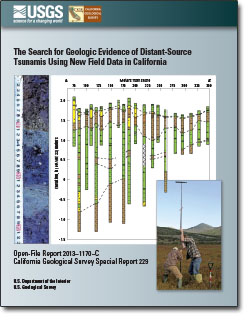Skip Links
USGS Open-File Report 2013–1170 and CGS Special Report 229, Chapter C
The Search for Geologic Evidence of Distant-Source
Tsunamis Using New Field Data in California
By Rick Wilson, Eileen Hemphill-Haley, Bruce Jaffe, Bruce Richmond, Robert Peters, Nick Graehl, Harvey Kelsey,
Robert Leeper, Steve Watt, Mary McGann, Don Hoirup, Catherine Chagué-Goff, James Goff, Dylan Caldwell, and
Casey Loofbourrow
 Abstract Abstract
A statewide assessment for geological evidence of tsunamis, primarily from distant-source
events, found tsunami deposits at several locations, though evidence was absent at most locations
evaluated. Several historical distant-source tsunamis, including the 1946 Aleutian, 1960 Chile, and 1964
Alaska events, caused inundation along portions of the northern and central California coast. Recent
numerical tsunami modeling results identify the eastern Aleutian Islands subduction zone as the “worstcase”
distant-source region, with the potential for causing tsunami runups of 7–10 m in northern and
central California and 3–4 m in southern California. These model results, along with a review of
historical topographic maps and past geotechnical evaluations, guided site selection for tsunami deposit
surveys. A reconnaissance of 20 coastal marshlands was performed through site visits and coring of
shallow surface sediments to determine if evidence for past tsunamis existed. Although conclusive
evidence of tsunami deposits was not found at most of the sites evaluated, geologic evidence consistent
with tsunami inundation was found at two locations: Three marshes in the Crescent City area and Pillar
Point marsh near Half Moon Bay. Potential tsunami deposits were also evaluated at the Carpinteria Salt
Marsh Reserve in Santa Barbara County. In Crescent City, deposits were ascribed to tsunamis on the
basis of stratigraphic architecture, particle size, and microfossil content, and they were further assigned
to the 1964 Alaska and 1700 Cascadia tsunamis on the basis of dating by cesium-137 and radiocarbon
methods, respectively. The 1946 tsunami sand deposit was clearly identified throughout Pillar Point
marsh, and one to two other similar but highly discontinuous sand layers were present within 0.5 m of
the surface. A tsunami-origin interpretation for sand layers at Carpinteria is merely consistent with
graded bedding and unsupported by diatom or foraminiferal assemblages. Additional studies, including
age dating, grain-size, and microfossil analyses are underway for the deposits at Crescent City, Pillar
Point marsh, and Carpinteria, which may help further identify if other tsunami deposits exist at those
sites. The absence of evidence for tsunamis at other sites examined should not preclude further work
beyond the reconnaissance-level investigations at those locations.
|
First posted May 20, 2014
Part or all of this report is presented in Portable Document Format (PDF). For best results viewing and printing PDF documents, it is recommended that you download the documents to your computer and open them with Adobe Reader. PDF documents opened from your browser may not display or print as intended. Download the latest version of Adobe Reader, free of charge.
|
Suggested citation:
Wilson, R., Hemphill-Haley, E., Jaffe, B., Richmond, B., Peters, R., Graehl, N., Kelsey, H., Leeper, R., Watt, S.,
McGann, M., Hoirup, D., Chague-Goff, C., Goff, J., Caldwell, D., and Loofbourrow, C., 2014, The search for
geologic evidence of distant-source tsunamis using new field data in California, chap. C of Ross, S.L., and Jones,
L.M., eds., The SAFRR (Science Application for Risk Reduction) tsunami scenario: U.S. Geological Survey Open-File Report 2013–1170–C, 122 p., http://dx.doi.org/10.3133/ofr20131170c.
ISSN 2331-1258 (online)
Contents
Abstract
Introduction
Significant Historical Tsunamis
Tsunami Deposit Investigation
Preliminary Results and Ongoing Work
References